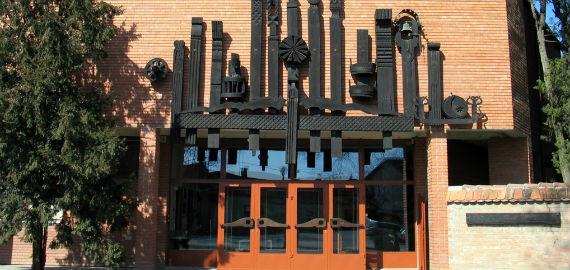2024. October 18. Friday
Attila József Museum - Makó
 |
Address: 6900, Makó Megyeház utca 4.
Phone number: (62) 213-540, (20) 610-0361
E-mail: jamuzeum@gmail.com
Opening hours: Tue-Sat 10-16
|
The exhibition has closed for visitors.
2009.03.14. 00:00
Museum tickets, service costs:
|
Individual ticket for adults
|
2800 HUF
|
|
|
Individual ticket for students
|
1400 HUF
|
|
|
Group ticket for students
(min. 10 people)
|
1200 HUF
|
/ capita
|
|
Individual ticket for pensioners
|
1400 HUF
|
|
|
Group ticket for pensioners
(min. 10 people)
|
1200 HUF
|
/ capita
|
|
Individual sponsors' ticket
|
5000 HUF
|
|
|
Guide
|
5000 HUF
|
|
|
Photography
|
500 HUF
|
An outstanding travelling exhibition is arriving at the József Attila Museum in Makó in March. Banners from the past centuries are shown at the flag history display by the Bánát Museum of Temesvár. The hundreds of year-old town, society and guild flags provide insight the past of Temesvár and that of Historic Hungary.

Flags and banners are the most important symbols of belonging and loyalty. Flags were imperative ever since ancient times. Totems and various rituals are considered the predecessors of flags designating the belonging to a certain group.
The present form of flags originated in the Far East. The Romans used flags first in Europe. These flags were red strips of textile fastened on a pole and carried in the front of soldiers in battle. The colour red is not by accident. In Roman mythology, the god of fire was pictured in red. Bolts were represented as divine fire.
By the Middle Ages, Flags were widespread all over Europe. However, these flags were not pieces of textile anymore. They were carriers of some kind of symbol or notion. Flags never departed from the side of humanity. They were so admired that condemnation of flags entailed serious punishment, anything, even death.
Every single flag is a milestone, stages of people, a community, glorious or disgraceful historic eras. Flags are also artistic works. They were made with attention. These historic imprints are on display at the József Attila Museum in Makó opening on 14 March.

Flags and banners are the most important symbols of belonging and loyalty. Flags were imperative ever since ancient times. Totems and various rituals are considered the predecessors of flags designating the belonging to a certain group.
The present form of flags originated in the Far East. The Romans used flags first in Europe. These flags were red strips of textile fastened on a pole and carried in the front of soldiers in battle. The colour red is not by accident. In Roman mythology, the god of fire was pictured in red. Bolts were represented as divine fire.
By the Middle Ages, Flags were widespread all over Europe. However, these flags were not pieces of textile anymore. They were carriers of some kind of symbol or notion. Flags never departed from the side of humanity. They were so admired that condemnation of flags entailed serious punishment, anything, even death.
Every single flag is a milestone, stages of people, a community, glorious or disgraceful historic eras. Flags are also artistic works. They were made with attention. These historic imprints are on display at the József Attila Museum in Makó opening on 14 March.
